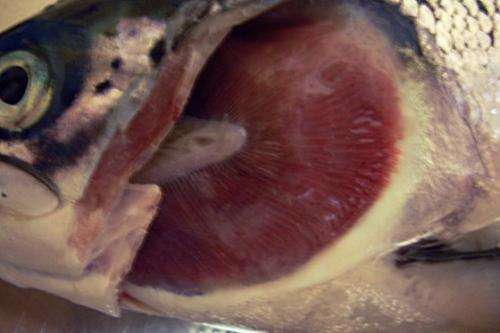Atlantic salmon suffering from amoebic gill disease Credit: Fiske-Liv A/S, Liv Birthe Rønneberg
Gill diseases in salmon farmed at sea lead to huge losses in some years and occur particularly in the autumn in salmon that has been released into the sea in the spring. Agnar Kvellestad's PhD thesis shows how several different causes play a role in the development of these diseases.
One of the diseases, proliferative gill inflammation (PGI) was identified in the 1980s. The biggest losses resulting from PGI have been in South West Norway. The causes have been partially identified, but more knowledge is needed so that preventive measures can be implemented to a larger degree than has been possible up until now.
By using light microscopy (histology), Kvellestad describes in detail the changes that occur in cases of PGI disease. PGI has several causes. In this study, a number of different pathogenic organisms were found in the gills of fish suffering from the disease. The study also appraises the effect of environmental factors.
One virus that was unknown up until now, the Atlantic salmon paramyxovirus, was isolated and characterised. The virus was detected in fish where there was an outbreak of PGI in gill tissue showing disease changes, but it was not documented as a primary cause of the disease. In addition, two different bacteria were found in the gills, one that was already known and another new one, which is normally found in so-called epithelial cysts and is called "Candidatus Branchiomonas cysticola". These bacteria may be among the primary causes of PGI. Parasites, which have also been detected, appear to be a secondary cause.
Kvellestad examined whether environmental factors can play a part in PGI by studying data registered by aquafarms and by the Norwegian Institute of Marine Research (www.imr.no/en). The results indicate that the prevalence of the disease is linked to high seawater temperatures, especially when the temperature of the surface water is high in august.
Another disease, amoeba-induced gill disease (AGD), was first diagnosed in Norway in late autumn 2006. It was detected in fish farms located furthest off the coast of Western Norway, i.e. in places with a high salt concentration. In 2006, the temperature of the sea was abnormally high in the surface water in August and also in deeper water during the late autumn. This disease has been a major problem for fish farming in Tasmania for many years and it may in the future lead to large losses in the Norwegian salmon farming industry.
Provided by Norwegian School of Veterinary Science
























